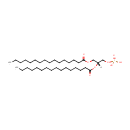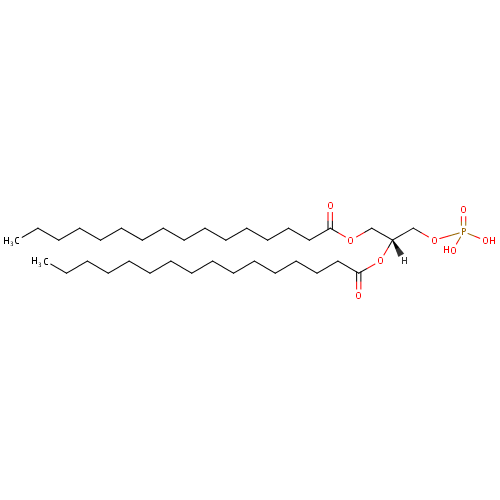
PA(16:0/16:0) (PAMDB000169)
| Record Information | |||||||||||||||||||||||||||||||||||||||||||||||||||||||||||||
|---|---|---|---|---|---|---|---|---|---|---|---|---|---|---|---|---|---|---|---|---|---|---|---|---|---|---|---|---|---|---|---|---|---|---|---|---|---|---|---|---|---|---|---|---|---|---|---|---|---|---|---|---|---|---|---|---|---|---|---|---|---|
| Version | 1.0 | ||||||||||||||||||||||||||||||||||||||||||||||||||||||||||||
| Update Date | 1/22/2018 11:54:54 AM | ||||||||||||||||||||||||||||||||||||||||||||||||||||||||||||
| Metabolite ID | PAMDB000169 | ||||||||||||||||||||||||||||||||||||||||||||||||||||||||||||
| Identification | |||||||||||||||||||||||||||||||||||||||||||||||||||||||||||||
| Name: | PA(16:0/16:0) | ||||||||||||||||||||||||||||||||||||||||||||||||||||||||||||
| Description: | PA(16:0/16:0) is a phosphatidic acid. It is a glycerophospholipid in which a phosphate moiety occupies a glycerol substitution site. As is the case with diacylglycerols, phosphatidic acids can have many different combinations of fatty acids of varying lengths and saturation attached at the C-1 and C-2 positions. Fatty acids containing 16, 18 and 20 carbons are the most common. PA(16:0/16:0), in particular, consists of one chain of palmitic acid at the C-1 position and one chain of palmitic acid at the C-2 position. Phosphatidic acids are quite rare but are extremely important as intermediates in the biosynthesis of triacylglycerols and phospholipids. Phospholipase Ds (PLDs), which catalyze the conversion of glycerolphospholipids, particularly phosphatidylcholine, to PAs and the conversion of N-arachidonoyl-phosphatidylethanolamine (NAPE) to anandamide and PAs are activated by several inflammatory mediators including bradykinin, ATP and glutamate. Circumstantial evidence that PAs are converted to DAGs. (PMID: 12618218, 16185776). | ||||||||||||||||||||||||||||||||||||||||||||||||||||||||||||
| Structure | |||||||||||||||||||||||||||||||||||||||||||||||||||||||||||||
| Synonyms: |
| ||||||||||||||||||||||||||||||||||||||||||||||||||||||||||||
| Chemical Formula: | C35H69O8P | ||||||||||||||||||||||||||||||||||||||||||||||||||||||||||||
| Average Molecular Weight: | 648.8913 | ||||||||||||||||||||||||||||||||||||||||||||||||||||||||||||
| Monoisotopic Molecular Weight: | 648.473005696 | ||||||||||||||||||||||||||||||||||||||||||||||||||||||||||||
| InChI Key: | PORPENFLTBBHSG-MGBGTMOVSA-N | ||||||||||||||||||||||||||||||||||||||||||||||||||||||||||||
| InChI: | InChI=1S/C35H69O8P/c1-3-5-7-9-11-13-15-17-19-21-23-25-27-29-34(36)41-31-33(32-42-44(38,39)40)43-35(37)30-28-26-24-22-20-18-16-14-12-10-8-6-4-2/h33H,3-32H2,1-2H3,(H2,38,39,40)/t33-/m1/s1 | ||||||||||||||||||||||||||||||||||||||||||||||||||||||||||||
| CAS number: | 7091-44-3 | ||||||||||||||||||||||||||||||||||||||||||||||||||||||||||||
| IUPAC Name: | [(2R)-2,3-bis(hexadecanoyloxy)propoxy]phosphonic acid | ||||||||||||||||||||||||||||||||||||||||||||||||||||||||||||
| Traditional IUPAC Name: | dipalmitoyl | ||||||||||||||||||||||||||||||||||||||||||||||||||||||||||||
| SMILES: | CCCCCCCCCCCCCCCC(=O)OC[C@H](COP(O)(O)=O)OC(=O)CCCCCCCCCCCCCCC | ||||||||||||||||||||||||||||||||||||||||||||||||||||||||||||
| Chemical Taxonomy | |||||||||||||||||||||||||||||||||||||||||||||||||||||||||||||
| Taxonomy Description | This compound belongs to the class of organic compounds known as 1,2-diacylglycerol-3-phosphates. These are glycerol-3-phosphates in which the glycerol moiety is bonded to two aliphatic chains through ester linkages. | ||||||||||||||||||||||||||||||||||||||||||||||||||||||||||||
| Kingdom | Organic compounds | ||||||||||||||||||||||||||||||||||||||||||||||||||||||||||||
| Super Class | Lipids and lipid-like molecules | ||||||||||||||||||||||||||||||||||||||||||||||||||||||||||||
| Class | Glycerophospholipids | ||||||||||||||||||||||||||||||||||||||||||||||||||||||||||||
| Sub Class | Glycerophosphates | ||||||||||||||||||||||||||||||||||||||||||||||||||||||||||||
| Direct Parent | 1,2-diacylglycerol-3-phosphates | ||||||||||||||||||||||||||||||||||||||||||||||||||||||||||||
| Alternative Parents | |||||||||||||||||||||||||||||||||||||||||||||||||||||||||||||
| Substituents |
| ||||||||||||||||||||||||||||||||||||||||||||||||||||||||||||
| Molecular Framework | Aliphatic acyclic compounds | ||||||||||||||||||||||||||||||||||||||||||||||||||||||||||||
| External Descriptors |
| ||||||||||||||||||||||||||||||||||||||||||||||||||||||||||||
| Physical Properties | |||||||||||||||||||||||||||||||||||||||||||||||||||||||||||||
| State: | Solid | ||||||||||||||||||||||||||||||||||||||||||||||||||||||||||||
| Charge: | -2 | ||||||||||||||||||||||||||||||||||||||||||||||||||||||||||||
| Melting point: | 161-165 °C | ||||||||||||||||||||||||||||||||||||||||||||||||||||||||||||
| Experimental Properties: |
| ||||||||||||||||||||||||||||||||||||||||||||||||||||||||||||
| Predicted Properties |
| ||||||||||||||||||||||||||||||||||||||||||||||||||||||||||||
| Biological Properties | |||||||||||||||||||||||||||||||||||||||||||||||||||||||||||||
| Cellular Locations: | Membrane | ||||||||||||||||||||||||||||||||||||||||||||||||||||||||||||
| Reactions: | Cytidine triphosphate + Hydrogen ion + PA(16:0/16:0) > CDP-1,2-didodecanoylglycerol + Pyrophosphate Cytidine triphosphate + Hydrogen ion + PA(16:0/16:0) > CDP-1,2-dihexadec-9-enoylglycerol + Pyrophosphate Cytidine triphosphate + Hydrogen ion + PA(16:0/16:0) > CDP-1,2-dihexadecanoylglycerol + Pyrophosphate Cytidine triphosphate + Hydrogen ion + PA(16:0/16:0) > CDP-1,2-dioctadec-11-enoylglycerol + Pyrophosphate Cytidine triphosphate + Hydrogen ion + PA(16:0/16:0) > CDP-1,2-Dioctadecanoylglycerol + Pyrophosphate Cytidine triphosphate + Hydrogen ion + PA(16:0/16:0) > CDP-1,2-ditetradec-7-enoylglycerol + Pyrophosphate Cytidine triphosphate + Hydrogen ion + PA(16:0/16:0) > CDP-1,2-ditetradecanoylglycerol + Pyrophosphate Adenosine triphosphate + Water + PA(16:0/16:0) > ADP + Hydrogen ion + Phosphate + PA(16:0/16:0) Adenosine triphosphate + Water + PA(16:0/16:0) > ADP + Hydrogen ion + Phosphate + PA(16:0/16:0) -->-->-->-->-->-->-->-->-->-->-->-->Water + PA(16:0/16:0) > 1,2-Diacyl-sn-glycerol (didodecanoyl, n-C12:0) + Phosphate Water + PA(16:0/16:0) > 1,2-Diacyl-sn-glycerol (dihexadec-9-enoyl, n-C16:1) + Phosphate Water + PA(16:0/16:0) > 1,2-Diacyl-sn-glycerol (dihexadecanoyl, n-C16:0) + Phosphate More...Water + PA(16:0/16:0) > 1,2-Diacyl-sn-glycerol (dioctadec-11-enoyl, n-C18:1) + Phosphate Water + PA(16:0/16:0) > 1,2-Diacyl-sn-glycerol (ditetradec-7-enoyl, n-C14:1) + Phosphate Water + PA(16:0/16:0) > 1,2-Diacyl-sn-glycerol (ditetradecanoyl, n-C14:0) + Phosphate 1-Dodecanoyl-sn-glycerol 3-phosphate + Dodecanoyl-ACP (n-C12:0ACP) > acyl carrier protein + PA(16:0/16:0) 1-Hexadec-9-enoyl-sn-glycerol 3-phosphate + cis-hexadec-9-enoyl-[acyl-carrier protein] (n-C16:1) > acyl carrier protein + PA(16:0/16:0) 1-hexadecanoyl-sn-glycerol 3-phosphate + Palmitoyl-ACP (n-C16:0ACP) > acyl carrier protein + PA(16:0/16:0) 1-Octadec-11-enoyl-sn-glycerol 3-phosphate + cis-octadec-11-enoyl-[acyl-carrier protein] (n-C18:1) > acyl carrier protein + PA(16:0/16:0) 1-Octadecanoyl-sn-glycerol 3-phosphate + Octadecanoyl-ACP (n-C18:0ACP) > acyl carrier protein + PA(16:0/16:0) 1-Tetradec-7-enoyl-sn-glycerol 3-phosphate + cis-tetradec-7-enoyl-[acyl-carrier protein] (n-C14:1) > acyl carrier protein + PA(16:0/16:0) 1-Tetradecanoyl-sn-glycerol 3-phosphate + Myristoyl-ACP (n-C14:0ACP) > acyl carrier protein + PA(16:0/16:0) Water + PA(16:0/16:0) > 1-Dodecanoyl-sn-glycerol 3-phosphate + Dodecanoate (N-C12:0) + Hydrogen ion Water + PA(16:0/16:0) > 1-hexadecanoyl-sn-glycerol 3-phosphate + Hydrogen ion + Palmitic acid Water + PA(16:0/16:0) > 1-Octadec-11-enoyl-sn-glycerol 3-phosphate + Hydrogen ion + Octadecenoate (N-C18:1) Water + PA(16:0/16:0) > 1-Octadecanoyl-sn-glycerol 3-phosphate + Hydrogen ion + Octadecanoate (N-C18:0) Water + PA(16:0/16:0) > 1-Tetradec-7-enoyl-sn-glycerol 3-phosphate + Hydrogen ion + Tetradecenoate (N-C14:1) Water + PA(16:0/16:0) > 1-Tetradecanoyl-sn-glycerol 3-phosphate + Hydrogen ion + tetradecanoate (n-C14:0) Water + PA(16:0/16:0) > 2-dodecanoyl-sn-glycerol 3-phosphate + Dodecanoate (N-C12:0) Water + PA(16:0/16:0) > 2-hexadecanoyl-sn-glycerol 3-phosphate + Palmitic acid Water + PA(16:0/16:0) > 2-octadec-11-enoyl-sn-glycerol 3-phosphate + Octadecenoate (N-C18:1) Water + PA(16:0/16:0) > 2-octadecanoyl-sn-glycerol 3-phosphate + Octadecanoate (N-C18:0) Water + PA(16:0/16:0) > 2-tetradec-7-enoyl-sn-glycerol 3-phosphate + Tetradecenoate (N-C14:1) Water + PA(16:0/16:0) > 2-tetradecanoyl-sn-glycerol 3-phosphate + tetradecanoate (n-C14:0) CDP-1,2-didodecanoylglycerol + Water > Cytidine monophosphate +2 Hydrogen ion + PA(16:0/16:0) CDP-1,2-dihexadec-9-enoylglycerol + Water > Cytidine monophosphate +2 Hydrogen ion + PA(16:0/16:0) CDP-1,2-dihexadecanoylglycerol + Water > Cytidine monophosphate +2 Hydrogen ion + PA(16:0/16:0) CDP-1,2-dioctadec-11-enoylglycerol + Water > Cytidine monophosphate +2 Hydrogen ion + PA(16:0/16:0) CDP-1,2-Dioctadecanoylglycerol + Water > Cytidine monophosphate +2 Hydrogen ion + PA(16:0/16:0) CDP-1,2-ditetradec-7-enoylglycerol + Water > Cytidine monophosphate +2 Hydrogen ion + PA(16:0/16:0) CDP-1,2-ditetradecanoylglycerol + Water > Cytidine monophosphate +2 Hydrogen ion + PA(16:0/16:0) 1,2-Diacyl-sn-glycerol (didodecanoyl, n-C12:0) + Adenosine triphosphate > ADP + Hydrogen ion + PA(16:0/16:0) 1,2-Diacyl-sn-glycerol (dihexadec-9-enoyl, n-C16:1) + Adenosine triphosphate > ADP + Hydrogen ion + PA(16:0/16:0) 1,2-Diacyl-sn-glycerol (dihexadecanoyl, n-C16:0) + Adenosine triphosphate > ADP + Hydrogen ion + PA(16:0/16:0) 1,2-Diacyl-sn-glycerol (dioctadec-11-enoyl, n-C18:1) + Adenosine triphosphate > ADP + Hydrogen ion + PA(16:0/16:0) 1,2-Diacyl-sn-glycerol (ditetradec-7-enoyl, n-C14:1) + Adenosine triphosphate > ADP + Hydrogen ion + PA(16:0/16:0) 1,2-Diacyl-sn-glycerol (ditetradecanoyl, n-C14:0) + Adenosine triphosphate > ADP + Hydrogen ion + PA(16:0/16:0) CDP-diacylglycerol + Water <> Cytidine monophosphate + PA(16:0/16:0) Cytidine triphosphate + PA(16:0/16:0) <> Pyrophosphate + CDP-diacylglycerol Adenosine triphosphate + 1,2-Diacyl-sn-glycerol + 1,2-Diacyl-sn-glycerol <> ADP + PA(16:0/16:0) PA(16:0/16:0) + Coenzyme A + Acyl-CoA + 1-Acyl-sn-glycerol 3-phosphate <> 1-Acyl-sn-glycerol 3-phosphate + Acyl-CoA Acyl-[acyl-carrier protein] + 1-Acyl-sn-glycerol 3-phosphate <> Acyl-carrier protein + PA(16:0/16:0) a 1,2-diacyl-<i>sn</i>-glycerol 3-diphosphate + Water PA(16:0/16:0) + Phosphate + Hydrogen ion a CDP-diacylglycerol + Water <> PA(16:0/16:0) + Cytidine monophosphate + Hydrogen ion Cytidine triphosphate + PA(16:0/16:0) + Hydrogen ion > Pyrophosphate + a CDP-diacylglycerol Adenosine triphosphate + a 1,2-diacylglycerol <> Hydrogen ion + PA(16:0/16:0) + ADP a 1-acyl-<i>sn</i>-glycerol-3-phosphate + a long-chain acyl-CoA > Coenzyme A + PA(16:0/16:0) | ||||||||||||||||||||||||||||||||||||||||||||||||||||||||||||
| Pathways: | |||||||||||||||||||||||||||||||||||||||||||||||||||||||||||||
| Spectra | |||||||||||||||||||||||||||||||||||||||||||||||||||||||||||||
| Spectra: |
| ||||||||||||||||||||||||||||||||||||||||||||||||||||||||||||
| References | |||||||||||||||||||||||||||||||||||||||||||||||||||||||||||||
| References: |
| ||||||||||||||||||||||||||||||||||||||||||||||||||||||||||||
| Synthesis Reference: | Ando, Yoshihiro; Oda, Hiroshi; Matsuyoshi, Shigeru; Maekawa, Naoya. Manufacture of phosphatidic acid alkali metal or ammonium salts using phospholipase D. Jpn. Kokai Tokkyo Koho (2001), 8 pp. | ||||||||||||||||||||||||||||||||||||||||||||||||||||||||||||
| Material Safety Data Sheet (MSDS) | Download (PDF) | ||||||||||||||||||||||||||||||||||||||||||||||||||||||||||||
| Links | |||||||||||||||||||||||||||||||||||||||||||||||||||||||||||||
| External Links: |
| ||||||||||||||||||||||||||||||||||||||||||||||||||||||||||||
Enzymes
- General function:
- Involved in transferase activity, transferring phosphorus-containing groups
- Specific function:
- CTP + phosphatidate = diphosphate + CDP- diacylglycerol
- Gene Name:
- cdsA
- Locus Tag:
- PA3651
- Molecular weight:
- 28.9 kDa
Reactions
| CTP + phosphatidate = diphosphate + CDP-diacylglycerol. |
- General function:
- Involved in diacylglycerol kinase activity
- Specific function:
- Recycling of diacylglycerol produced during the turnover of membrane phospholipid
- Gene Name:
- dgkA
- Locus Tag:
- PA3603
- Molecular weight:
- 13.1 kDa
Reactions
| ATP + 1,2-diacylglycerol = ADP + 1,2-diacyl-sn-glycerol 3-phosphate. |
- General function:
- Involved in nucleotide binding
- Specific function:
- Involved in lipid A export and possibly also in glycerophospholipid export and for biogenesis of the outer membrane. Transmembrane domains (TMD) form a pore in the inner membrane and the ATP-binding domain (NBD) is responsible for energy generation
- Gene Name:
- msbA
- Locus Tag:
- PA4997
- Molecular weight:
- 66.4 kDa
Transporters
- General function:
- Involved in nucleotide binding
- Specific function:
- Involved in lipid A export and possibly also in glycerophospholipid export and for biogenesis of the outer membrane. Transmembrane domains (TMD) form a pore in the inner membrane and the ATP-binding domain (NBD) is responsible for energy generation
- Gene Name:
- msbA
- Locus Tag:
- PA4997
- Molecular weight:
- 66.4 kDa
- General function:
- Secondary metabolites biosynthesis, transport and catabolism
- Specific function:
- Part of the ABC transporter complex mlaFEDB that actively prevents phospholipid accumulation at the cell surface. Probably maintains lipid asymmetry in the outer membrane by retrograde trafficking of phospholipids from the outer membrane to the inner membrane
- Gene Name:
- mlaE
- Locus Tag:
- PA4455
- Molecular weight:
- 28.4 kDa

